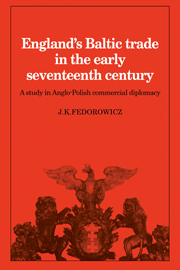 England's Baltic Trade in the Early Seventeenth Century
England's Baltic Trade in the Early Seventeenth Century Published online by Cambridge University Press: 05 November 2011
The nature of the sources
In attempting to illuminate England's Baltic trade in the seventeenth century by studying the extant shipping records of the period, one immediately encounters severe limitations. Perhaps the most serious is simply that such a study of necessity ignores any overland traffic. It is certain that at least some English cloth reached Poland by way of the overland route from Hamburg, but the evidence for this is fragmentary at best. In the winter of 1608, when the sea lanes became dangerous, Cranfield's factors at Stade inquired about the rates for transportation of cloth by land. After Danzig obtained in 1628 the odious sealing privilege on all cloth imports to Poland, the English were quick to inquire as to whether this included imports by land: Sir Thomas Roe managed to secure from the Polish government an interpretation which specifically excluded overland imports from Germany and Constantinople (sic), and in this way freed as many as 1,000 cloths stayed at Frankfurt am Oder until a decision should be made on the applicability of Danzig's privilege. Rybarski discusses overland cloth imports to Poland in very general terms and it is difficult to determine from his account whether or not any substantial amounts of English cloth entered Poland through her western borders. Heckscher, on the other hand, suggests that apparent trade imbalances in the Baltic's maritime exchanges might have been rectified by overland shipments. For this to have been the case, the overland shipments would have had to have been substantial indeed.
To save this book to your Kindle, first ensure [email protected] is added to your Approved Personal Document E-mail List under your Personal Document Settings on the Manage Your Content and Devices page of your Amazon account. Then enter the ‘name’ part of your Kindle email address below. Find out more about saving to your Kindle.
Note you can select to save to either the @free.kindle.com or @kindle.com variations. ‘@free.kindle.com’ emails are free but can only be saved to your device when it is connected to wi-fi. ‘@kindle.com’ emails can be delivered even when you are not connected to wi-fi, but note that service fees apply.
Find out more about the Kindle Personal Document Service.
To save content items to your account, please confirm that you agree to abide by our usage policies. If this is the first time you use this feature, you will be asked to authorise Cambridge Core to connect with your account. Find out more about saving content to Dropbox.
To save content items to your account, please confirm that you agree to abide by our usage policies. If this is the first time you use this feature, you will be asked to authorise Cambridge Core to connect with your account. Find out more about saving content to Google Drive.